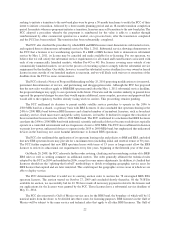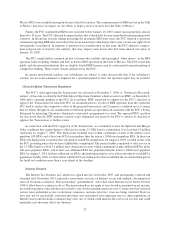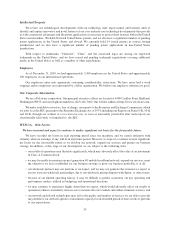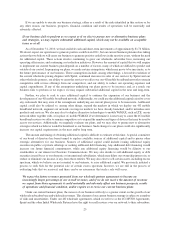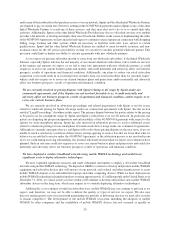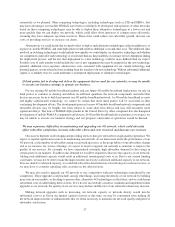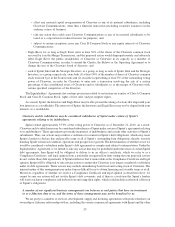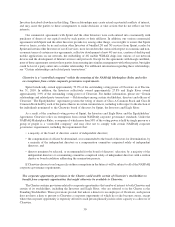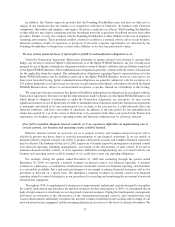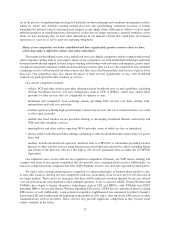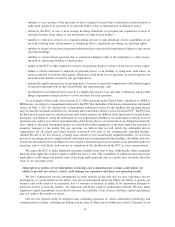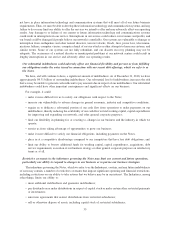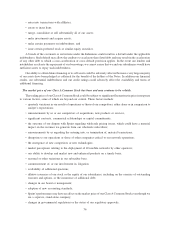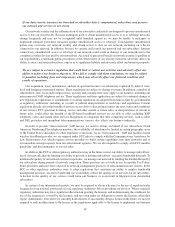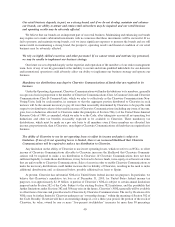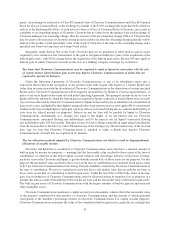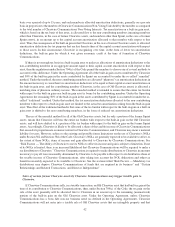Clearwire 2010 Annual Report Download - page 37
Download and view the complete annual report
Please find page 37 of the 2010 Clearwire annual report below. You can navigate through the pages in the report by either clicking on the pages listed below, or by using the keyword search tool below to find specific information within the annual report.are in the process of implementing an integrated materials resource planning and warehouse management system,
which we expect will automate existing manual processes and consolidating warehouse locations to further
strengthen the internal controls and transaction integrity in our supply chain. Although we believe we have made
sufficient progress in remediating these deficiencies so that they no longer represent a material weakness, in the
future we may determine that we have other deficiencies in our internal controls that could harm our business
operations or cause us to fail to meet our reporting obligations.
Many of our competitors are better established and have significantly greater resources than we have,
which may make it difficult to attract and retain subscribers.
The market for broadband access, voice and related services is highly competitive and we compete with several
other companies within each of our markets. Some of our competitors are well established with larger and better
developed networks and support systems, longer-standing relationships with customers and suppliers, greater name
recognition and greater financial, technical and marketing resources than we have. Our competitors may subsidize
competing services with revenue from other sources and, thus, may offer their products and services at prices lower
than ours. Our competitors may also reduce the prices of their services significantly or may offer broadband
connectivity packaged with other products or services.
Our current competitors include:
• cellular, PCS and other wireless providers offering wireless broadband services and capabilities, including
offering broadband services over new technologies such as LTE or HSPA+, which may enable these
providers to offer services that are comparable or superior to ours;
• incumbent and competitive local exchange carriers providing DSL services over their existing wide,
metropolitan and local area networks;
• wireline operators offering high-speed Internet connectivity services and voice communications over cable
or fiber optic networks;
• satellite and fixed wireless service providers offering or developing broadband Internet connectivity and
VoIP and other telephony services;
• municipalities and other entities operating Wi-Fi networks, some of which are free or subsidized;
• electric utilities and other providers offering or planning to offer broadband Internet connectivity over power
lines; and
• resellers, mobile virtual network operators, which we refer to as MVNOs, or wholesalers providing wireless
Internet or other wireless services using infrastructure developed and operated by others, including Sprint
and certain of the Investors who have the right to sell services purchased from us under the 4G MVNO
Agreement.
Our residential voice service will also face significant competition. Primarily, our VoIP service offering will
compete with many of our current competitors that also provide voice communications services. Additionally, we
may face competition from companies that offer VoIP telephony services over networks operated by third parties.
We expect other existing and prospective competitors to adopt technologies or business plans similar to ours,
or seek other means to develop services competitive with ours, particularly if our services prove to be attractive in
our target markets. There can be no assurances that there will be sufficient customer demand for services offered
over our network in the same markets to allow multiple operators, if any, to succeed. AT&T, Verizon Wireless and
T-Mobile have begun to deploy alternative technologies such as LTE and HSPA+, with T-Mobile and AT&T
launching HSPA+ service and Verizon Wireless launching LTE service. AT&T has also announced plans to launch
LTE service as well. Additionally, a new potential competitor, LightSquared, has announced its plans to launch a
nationwide LTE and satellite network beginning in the middle of 2011 and to offer wholesale LTE services to other
communications services providers. These services may provide significant competition as they become more
widely available in the future.
32


